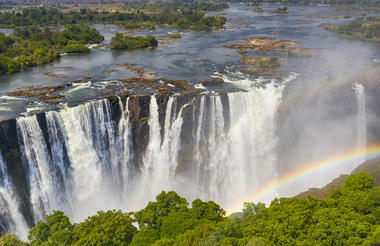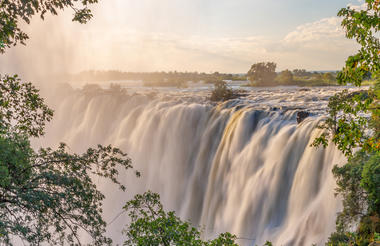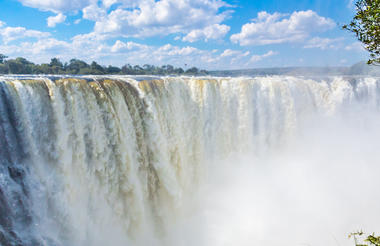With its well-developed infrastructure, some of the best tourist facilities in Africa and an impressive list of breathtaking natural wonders, touring Namibia is truly a pleasure. Visit the capital of Windhoek and the lovely coastal town of Swakopmund to discover remnants of the country’s German influence, reflected in the architecture, culture, cuisine and the annual Oktoberfest celebrations. To properly appreciate this extraordinary country, you will have to venture out of the cities to explore the remarkable natural landscapes Namibia has to offer. These include: the impressive Fish River Canyon Park; the vast Etosha National Park teeming with local subspecies, such as desert lions, desert elephants and the Hartmann's Mountain Zebra; the hauntingly beautiful Kalahari Desert; and of course the Namib Desert stretching for nearly 1000 km along the magnificent Atlantic coastline. Namibia is an ideal destination for travellers seeking an unforgettable African experience in a uniquely beautiful untamed wilderness.
Namibia’s capital, Windhoek, is a cosmopolitan city with an abundance of restaurants, shops, entertainment venues and accommodation. Windhoek is clean, safe and well-organised. The city centre is an interesting architectural mix of historical and modern buildings. The colonial legacy is still alive in its many German eateries and shops and the fairly widespread use of the German language.
City centre sights within easy walking distance: the Alte Feste (Old Fortress) museum; Christuskirche (Christ Church), consecrated in 1910; Tintenpalast (built in 1912/1913 as the seat of the colonial government and nicknamed Ink Palace), which is part of the parliamentary complex; the massive Independence Memorial Museum and the imposing contemporary building of the Supreme Court.
The international airport is 40 km east of Windhoek.
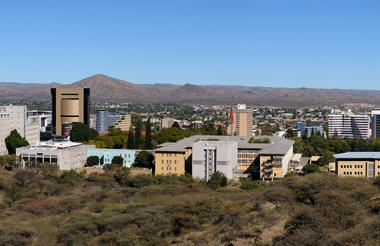
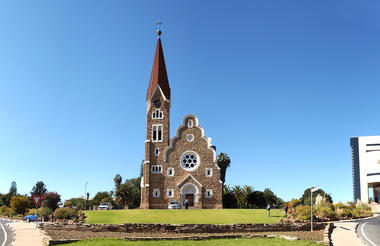

The desert town of Solitaire, in the south-western Khomas Region of central Namibia, is like a small oasis. There is not much to do or see in this tiny village, other than stop for refreshments and filling up with petrol. Solitaire boasts the only petrol station, general store and post office between Sossusvlei and Walvis Bay. There is also a small bar and a bakery famous for its apple pie – said to be the best in the country – as well as a luxury lodge, a motel and a campsite.
Activities: Enjoy a scenic sundowner with spectacular views of the Namib Desert; take time for a hike; go biking through unspoilt natural scenery; visit the local cheetah sanctuary.
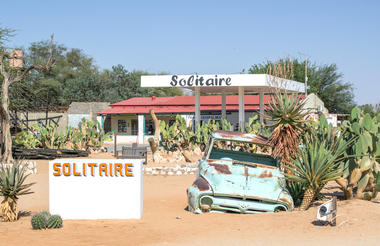
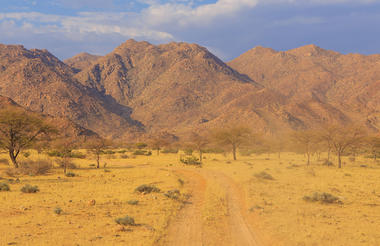
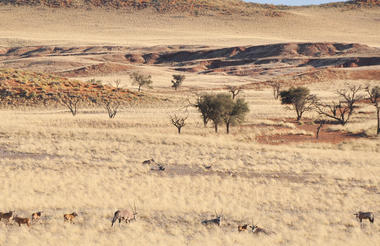
As previously described

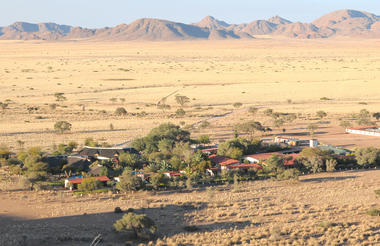
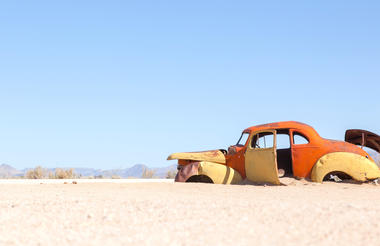
In 1892, eight years after South West Africa was declared a German Protectorate, Swakopmund was founded with the intention to build a harbour. By 1907 a little town pulsating with life had emerged from the desert! Swakopmund boasted the largest European population of all the German colonies in Africa. Decades on and much bigger now, the charming town is as alluring as ever. The mix of Namibian influences with picturesque buildings from the colonial era, palm-lined streets and seaside promenades, the laid-back holiday atmosphere plus the cool sea breeze make Swakopmund one of the most attractive places in the country.
Despite the turquoise waters of the Atlantic Ocean on its doorstep and the Namib Desert as its backyard, Swakopmund is not a tropical sunbathing paradise, however. The moderate climate along the coast is due to the cold Benguela Current. The current also causes the nightly fogs for which the town is famous and which sustain the wealth of desert flora and fauna near the coast. Early mornings and the evenings can be chilly throughout the year – a welcome respite from the inland heat.
Swakopmund has become the country’s adventure mecca. The desert, the dunes and the ocean lend themselves to a host of thrilling activities: sandboarding, sand skiing, quad biking, dune carting, beach angling and deep sea fishing, to name but a few, and not to forget parachuting.
There is no shortage of diverse shops, bistros and restaurants. Small specialist shops sell hand-made leather work, art & crafts, hand-woven carpets and wall hangings, hand-embroidered bed and table linen and other items proudly made in Namibia. Superb jewellery, designed and crafted with local gemstones by master goldsmiths, are another special feature of Swakopmund.
Activities other than fun in the sand and the sea: visit the art galleries and buy contemporary Namibian art and crafts; visit the museum to learn about Swakopmund’s history; join a tour of Karakulia Weavers and watch karakul wool being spun and woven into wall hangings and rugs; admire the world's largest quartz crystal cluster and other mineral treasures at the Kristall Galerie.
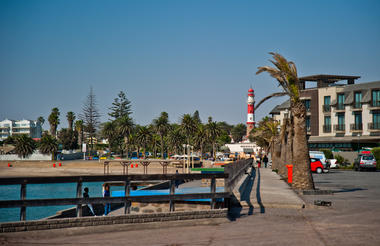


Palmwag Lodge, halfway between Swakopmund and Etosha, is idyllically located among tall Makalani palm trees on the banks of the seasonal Uniab River. It is one of Namibia's oldest and most popular tourist destinations. The availability of water often lures elephants closer to the lodge. Palmwag manages the concession area around the lodge, a vast nature park of 5500 km² which boasts the largest predator populations outside Etosha National Park and most of the world’s free-roaming Black rhino. There are also healthy numbers of the legendary desert-adapted elephant as well as mountain zebra, giraffe, springbok, kudu and more.

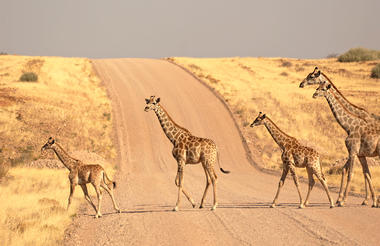
Etosha National Park in the central north is world-famous for its abundance of wildlife and premiere game viewing opportunities. The park is home to 114 species of mammals, including elephants, black rhinos, lions and other big cats and predators, giraffes, various antelopes and zebras, as well as hundreds of species of birds and reptiles. The vegetation ranges from dense bush to open plains with semi-arid savannah grasslands. During the dry season and in times of drought, the animals flock to the perennial springs and artificial waterholes which are maintained all over the park.
Etosha Pan in the heart of the nature reserve is a vast shallow depression of 5000 kilometres2 that can even be seen from space. The huge salt pan is dry for most of the year and lies shimmering in the heat, but after good rains it fills up with water and attracts scores of birds, especially flamingos from as far away as the Walvis Bay Lagoon on the Atlantic coast.
The western reaches of Etosha are quite different from its south-eastern and eastern parts. Even the characteristic white dust of the pan gives way to reddish-brown soil. The hills of western Etosha are the realm of Hartmann’s Mountain Zebra.
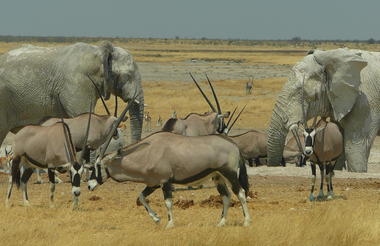
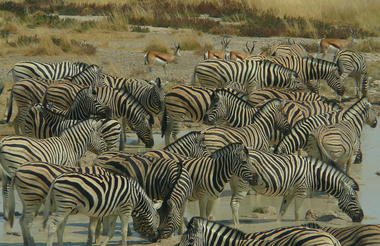
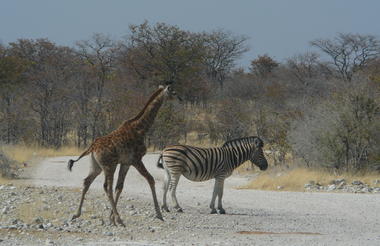
In most places in the park, the pans are devoid of vegetation with the exception of halophytic Sporobolus salsus, a protein-rich grass that is eaten by grazers like blue wildebeest and springbok. The areas around the Etosha pan also have other halophytic vegetation including grasses like Sporobolus spicatus and Odyssea paucinervis, as well as shrubs like Suaeda articulata. Most of the park is savanna woodlands except for areas close to the pan. Mopane is the most common tree, estimated to be around 80% of all trees in the park. The sandveld of north-eastern corner of Etosha is dominated by acacia and Terminalia trees. Tamboti trees characterize the woodlands south of the sandveld. Dwarf shrub savanna occurs areas close to the pan and is home to several small shrubs including a halophytic succulent Salsola etoshensis. Thorn bush savanna occurs close to the pan on limestone and alkaline soils and is dominated by acacia species such as Acacia nebrownii, Acacia luederitzii, Acacia melliferra, Acacia hebeclada and Acacia tortilis. Grasslands in the park are mainly around the Etosha pan where the soil is sandy. Depending on the soil and the effects of the pan, grasslands could be dominated by one of the Eragrostis, Sporobolus, Monelytrum, Odyssea or Enneapogon species.
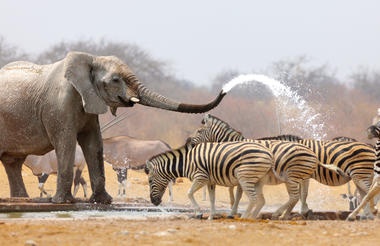
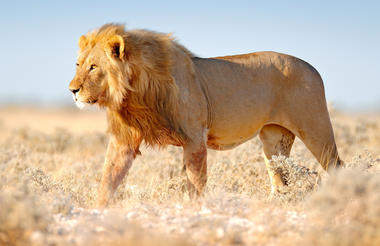
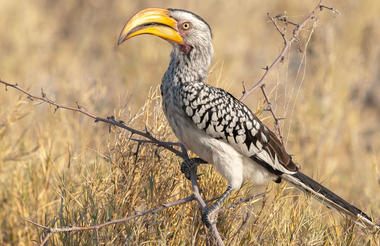
The Okavango River is the fourth-largest river system in southern Africa. From its source in Angola it runs south-eastward into Namibia and forms part of the border between Namibia and Angola. Just before it flows into Botswana and empties into the Okavango Delta, the river cascades over the Popa Falls, dropping four metres over a series of rapids.
The city of Rundu on the banks of the Okavango is the capital of Kavango-East, a region known for its lush vegetation, spectacular natural beauty, abundant wildlife and some 400 species of birds. With 150 species of fish the river is a popular fishing destination.
Activities: Take a scenic boat cruise; go birding; visit the nature reserves in this region; see the Popa Falls; explore Rundu.


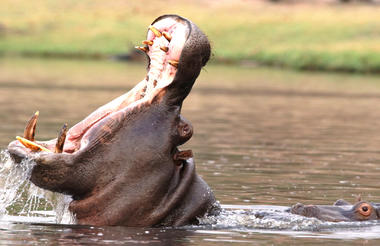
Meandering through the spectacular Zambezi Region in north-western Namibia, the Kwando River forms the border between Namibia and Botswana near the end of its course. The area along the Kwando is known for the game reserves, national parks and wildlife sanctuaries which offer excellent game viewing opportunities. The perennial river attracts plenty of wildlife – large herds of elephants, hippos, crocodiles, turtles, spotted-necked otters, zebra, impala and red lechwe, to name but a few, as well as more than 400 bird species. Accommodation is provided by numerous lodges on the banks of the river.
Activities: Game viewing; bird watching; river cruising; fishing; go camping; relax and soak up the spectacular views of wild Africa.



The Zambezi Region, previously known as the Caprivi Strip, is Namibia’s “panhandle” that juts out eastwards between Angola and Botswana all the way to Zimbabwe. Its easternmost tip is the only spot on the planet where four countries meet. The Zambezi Region lies in the middle of one of Africa’s largest and best-known game-viewing areas. It is part of the Kavango-Zambezi Transfrontier Conservation Area (KAZA), which combines 36 game reserves in Namibia, Angola, Zambia, Botswana and Zimbabwe. Since there are no fences, animals can move freely between the neighbouring countries. The abundance of water supplied by the Zambezi, Okavango, Kwando and Chobe rivers sustains a large variety of animal and bird species.
Activities: Enjoy manifold game-viewing opportunities; go bird watching; go angling for tigerfish in the Zambezi River; join river cruises; soak up the natural splendour of this scenic region.



Situated in the southern reaches of Africa, Botswana is renowned for its pristine wilderness areas characterised by deep lagoons, wetlands, lush palms, rugged hills and desert plains. The country’s primary tourist drawcard is undoubtedly the vast red expanse of the Kalahari Desert and its remarkably beautiful Okavango Delta, the largest inland delta in the world. These natural wonders provide a tranquil haven for an abundance of African wildlife to thrive. Other highlights include the impressive Makgadikgadi Salt Pans, where visitors are privy to massive zebra migrations during the flood season; the Savuti plains, which host a significant pride of lions; and the Tsodilo Hills, where 4500 rock paintings form a unique record of human settlement over many millennia.
Tucked away in the northeastern corner of Botswana, on the banks of the famous Chobe River, the scenic little town of Kasane rests on the doorstep of the spectacular Chobe National Park. There are no boundary fences separating the village from the park and game such as elephant and hippo are often spotted roaming around the town. If on the lookout for elusive game, pay a visit to the Sedudu Valley Road, where large dead trees provide temporary homes for leopards. Within Kasane, an ancient baobab tree stands on display, once serving as a local prison. Visitors can look forward to a multitude of activities including: enjoying a game drive through the park, taking a sunset cruise down the Chobe River, visiting a local village or jumping on a day trip to the breathtaking Victoria Falls.
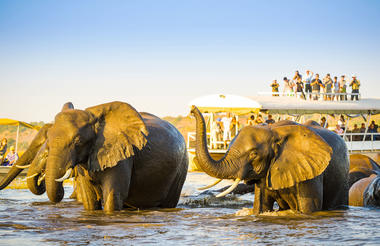
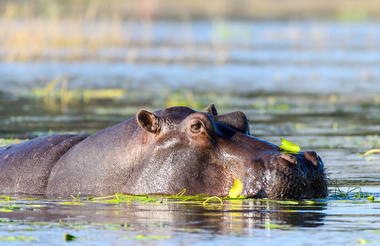
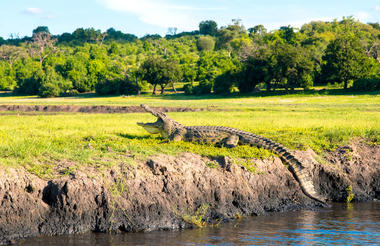
A nation of spectacular natural beauty, friendly people and rich culture, Zimbabwe’s status as one of Africa’s leading safari destinations was dampened for years by its political instability. But now that the country is transcending its strife and returning to a state of equilibrium, it is once again emerging as a vacation highlight of the continent. Victoria Falls – known to locals as ‘The Smoke That Thunders’ – is one of the seven natural wonders of the world and the sheer power of this massive body of water plunging into the Zambezi Gorge is awe-inspiring and unforgettable. Lake Kariba, with its game-rich shores and islands, is an idyllic safari spot featuring mind-blowing sunsets; Hwange National Park is known for its huge herds of elephants; and a kayak trip down the Zambezi through the Mana Pools National Park will appeal to the intrepid traveller, providing close encounters with crocodiles, hippos and a host of other wildlife.
The iconic waterfalls in the Zambezi River are one of the Seven Natural Wonders of the World. About two-thirds are visible from the Zimbabwean side. While the spectacle of masses of cascading water is undoubtedly the star attraction, the area also offers adventure and sightseeing opportunities which certainly warrant a longer stay. Victoria Falls, the tourist town at the western side of the falls, is easy to explore on foot. It has some excellent accommodation and restaurants and, of course, an eclectic variety of African curios and authentic art sold by friendly locals who are wonderfully welcoming and eager to help visitors enjoy the experience.
Activities: Scenic flights over the falls by helicopter or microlight; bungee jumping off the Victoria Falls Bridge; white-water rafting (seasonal); day trips to Chobe National Park.
